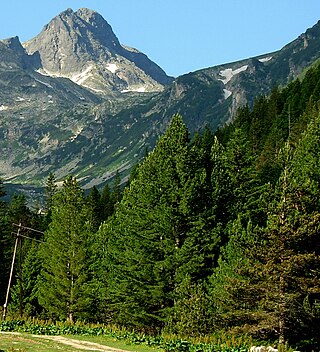
Pinus peuce is a species of pine native to the mountains of North Macedonia, Bulgaria, Albania, Montenegro, Kosovo, the extreme southwest of Serbia, and the extreme north of Greece, growing typically at (600-) 1,000-2,200 (-2,300) m altitude. It often reaches the alpine tree line in this area. The mature size is up to 35–40 m height, and 1.5 m trunk diameter. However, the height of the tree diminishes strongly near the upper tree line and may even obtain shrub sizes.

Pinus strobiformis, commonly known as southwestern white pine, Mexican white pine or Chihuahua white pine, is a medium-sized white pine tree whose native habitat is in southwestern United States and Mexico. It is typically a high-elevation pine growing mixed with other conifers.

Pinus canariensis, the Canary Island pine, is a species of gymnosperm in the conifer family Pinaceae. It is a large, evergreen tree, native and endemic to the outer Canary Islands of the Atlantic Ocean.

Pinus serotina, the pond pine, black bark pine, bay pine,marsh pine, or pocosin pine, is a pine tree found along the Southeastern portion of the Atlantic coastal plain of the United States, from southern New Jersey south to Florida and west to southern Alabama. Pond pine distribution may be starting to spread west towards Mississippi and Tennessee.

Pinus virginiana, the Virginia pine, scrub pine, Jersey pine, possum pine, is a medium-sized tree, often found on poorer soils from Long Island in southern New York south through the Appalachian Mountains to western Tennessee and Alabama. The usual size range for this pine is 9–18 m, but can grow larger under optimum conditions. The trunk can be as large as 20 inches diameter. This tree prefers well-drained loam or clay, but will also grow on very poor, sandy soil, where it remains small and stunted. The typical life span is 65 to 90 years.
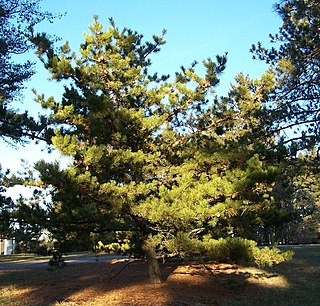
Table Mountain pine, Pinus pungens, also called hickory pine, prickly pine, or mountain pine, is a small pine native to the Appalachian Mountains in the United States.

Pinus bhutanica, which may be called the Bhutan white pine, is a tree restricted to Bhutan and adjacent parts of northeast India and southwest China. Along with the related Pinus wallichiana it is a constituent of lower altitude blue pine forests. This pine reaches a height of 25 meters. Note that P. wallichiana is sometimes called by the common name 'Bhutan pine'.
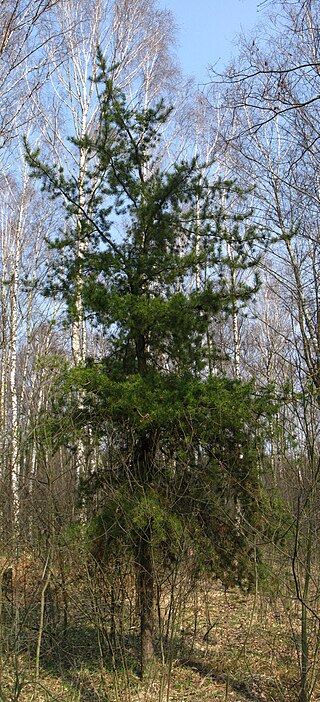
Jack pine, also known as grey pine or scrub pine, is a North American pine.

Pinus glabra, the spruce pine, is a tree found on the coastal plains of the southern United States, from southern South Carolina south to northern Florida and west to southern Louisiana.

The stone pine, botanical name Pinus pinea, also known as the Italian stone pine, Mediterranean stone pine, umbrella pine and parasol pine, is a tree from the pine family (Pinaceae). The tree is native to the Mediterranean region, occurring in Southern Europe and the Levant. The species was introduced into North Africa millennia ago, and is also naturalized in the Canary Islands, South Africa and New South Wales.
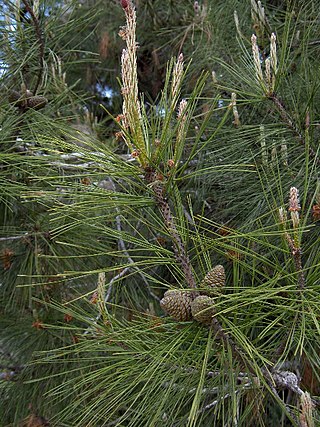
Pinus brutia, commonly known as the Turkish pine and Calabrian pine, is a species of pine native to the eastern Mediterranean region. The bulk of its range is in Turkey, but certain varieties are naturalized as far east as Afghanistan. It is also known as East Mediterranean pine, Afghan pine, and Brutia pine. The name "Calabrian pine" comes from an introduced grove in the Calabria region of southern Italy; historically this region was called Bruttium, which is likely where the specific epithet "brutia" comes from. Pinus brutia bears many similarities with other, closely related species such as Pinus halepensis and Pinus canariensis. Turkish pine forms a species complex with the former.
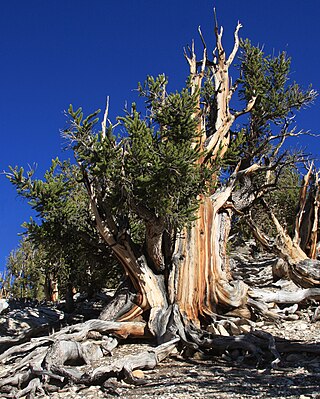
Pinus longaeva is a long-living species of bristlecone pine tree found in the higher mountains of California, Nevada, and Utah. Methuselah is a bristlecone pine that is 4,855 years old and has been credited as the oldest known living non-clonal organism on Earth. To protect it, the exact location of this tree is kept secret. In 1987, the bristlecone pine was designated one of Nevada's state trees.
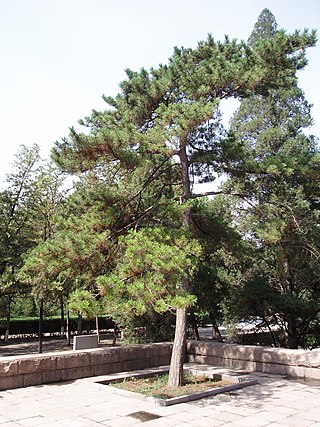
Pinus tabuliformis, also called Chinese red pine, Manchurian red pine, or Southern Chinese pine is a pine native to northern China and northern Korea.

Pinus kesiya is one of the most widely distributed pines in Asia. Its range extends south and east from the Khasi Hills in the northeast Indian state of Meghalaya, to northern Thailand, Philippines, Burma, Cambodia, Laos, southernmost China, and Vietnam. It is an important plantation species elsewhere in the world, including in southern Africa and South America.

Pinus aristata, the Rocky Mountain bristlecone pine, is a long-living species of bristlecone pine tree native to the United States. It appears in the Rocky Mountains in Colorado and northern New Mexico, with isolated populations in the San Francisco Peaks in Arizona and the Kaibab National Forest north of the Grand Canyon. It is usually found at very high altitudes, from 7,000–13,000 feet (2,100–4,000 m), in cold, dry subalpine climate conditions, often at the tree line, although it also forms extensive closed-canopy stands at somewhat lower elevations.

Pinus hwangshanensis, or Huangshan pine, is a species of pine endemic to the mountains of eastern China; it is named after the Huangshan Mountains in Anhui, from where it was first described.
Pinus squamata, the Qiaojia pine or southern lacebark pine, is a critically endangered pine native to a single locality consisting of about 20 trees in Qiaojia County, northeast Yunnan, China, at about 2,200 m (7,200 ft) elevation.
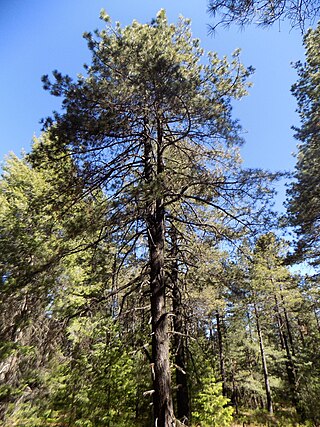
Pinus durangensis, the Durango pine, is a pine tree species endemic to the Sierra Madre Occidental mountain range of north-western Mexico.

Pinus maximartinezii, called Martinez pinyon, big-cone pinyon or maxipiñon, is a pine in the pinyon pine group, native to west-central Mexico.

Pinus herrerae, Herrera's pine, is a species of conifer in the family Pinaceae. It is found only in Mexico. It is a straight trunked tree, 30–35 m tall and 75–100 cm dbh.





















